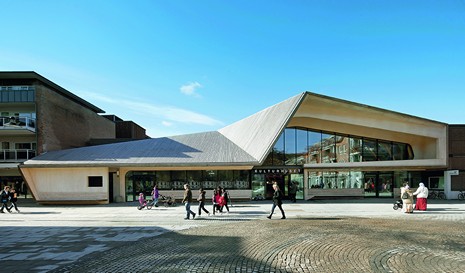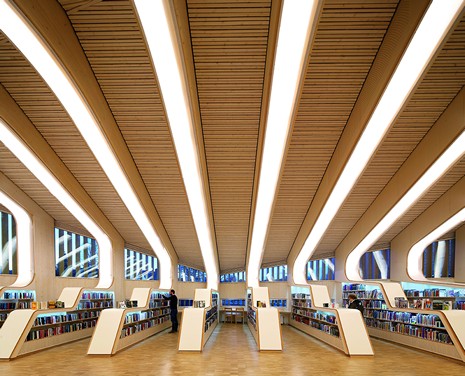Description
Designed by the Stavanger architectural firm Helen & Hard, the Vennesla Bibliotek og Kulturhus, housing the library and cultural center serves a small municipality in Vest-Agder, Norway. The 1,990 m² facility opened in 2011 after a 2005 decision to relocate to the town center. In its reincarnation as part of the main square, this project exemplifies some of the key characteristics of the 21st century public library.
Directly facing the town square, the library occupies a prominent infill site between an existing adult learning center and a community center with cinema. In adapting to the adjacent buildings, the library footprint angles from the pedestrian thoroughfare through to the block behind. A new glass facade on the square extends the length of both the library and the community center. Common entrances, a covered exterior loggia, a passageway through the library connecting the front and back and a shared lobby space merge the library and community center under the auspices of a Cultural Center (Kulturhus). In the first year, the combined activities provided by both programs brought in an excess of 100,000 visitors to this community of over 12,000.
The library comprises a single open room of books and reading, a small café, administrative offices and meeting rooms. Matching and, in parts, exceeding the height of the adjacent three-story buildings, the library is divided into a main level with a mezzanine and a lower level. At an imposing height of almost 6 m at the apex, the mezzanine level lifts up from the main floor to allow for the creation of the lower level. Books and reading space occupy the main level with offices and meeting rooms directly below.
Twenty-seven timber arches span the length of the irregularly shaped main level. Made possible by CNC technology, the arches stretch and shift to adapt to the geometry of the angled space while maintaining a constant center profile. Made from prefabricated glue-laminated timber, these arches are first structural ribs that support the roof. Each rib is constructed as a box unit in varying thickness, especially at the base. Faced by bent plywood, the depth of each unit is used for many secondary functions. It holds shelves, seats, lighting, and is habitable in parts. Its functions range from shelving to furniture, light fixture, space divider, signage, display, storage and HVAC chase. The architecture is performative in this concept of usable hybrid structures, a reflection of an ingrained 21st century trait, namely multi-tasking.
The use of wood as a material is pervasive not only in the interior, but throughout. Wood defines the exterior from the folding roof form to the vertical sun-shading wood fins that are highly visible on the side and the rear facades. Less visible elements such as the slab and the elevator shaft are also of wood, contributing to a total quantity of 450 m³ of glue-laminated timber in the project. This use of wood – in itself a symbol of Norwegian culture – is an embrace of renewable building materials that contributes to the library’s designation as a Class “A” low-energy Norwegian building.
The design of the Vennesla Library and Cultural Center is indicative of the many changes that have transformed the public library of old. Here, a move to the center of town results in a civic monumentality that is not premised on size. Engaged in its community, broadened in scope through borrowed program, constructed through digital construction technology and imbued with a material conscience, the Vennesla Library demonstrates the evolution of the 19th century one-room library model and the changing face of the 21st century public library.
Drawings
Lower level
Ground floor
Mezzanine
Cross section
Longitudinal section
East elevation
West elevation
Axonometric view showing sequence of integration
Photos

View of entry facade on the town square

The ribs are multi-functional as structure, lighting, bookcase and seat
Originally published in: Nolan Lushington, Wolfgang Rudorf, Liliane Wong, Libraries: A Design Manual, Birkhäuser, 2016.